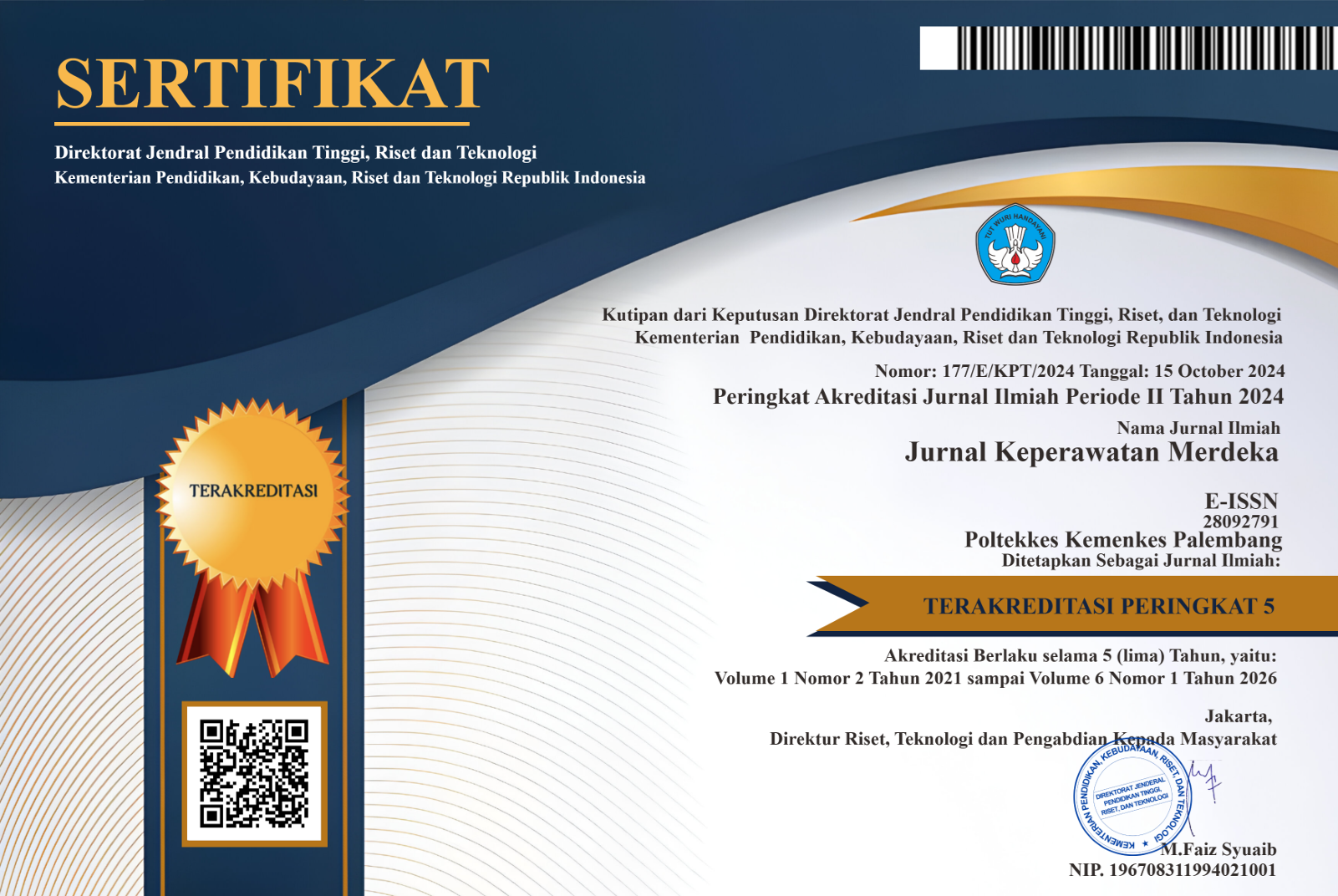Hambatan Perawat Dalam Memberikan Perawatan Paliatif Kepada Pasien: Kajian Literatur Integratif
Abstract
Latar belakang: Perawatan paliatif merupakan pendekatan yang bertujuan untuk meringankan gejala penyakit mengancam jiwa, yang berdampak pada aspek fisik, psikologis, sosial dan spiritual. Kebutuhan pelayanan paliatif semakin meningkat pada setiap tingkatan perawatan dan perawatan diberikan untuk meningkatkan kualitas hidup pasien dan keluarga. Berbagai hambatan yang di alami oleh perawat dalam memberikan perawatan paliatif di laporkan oleh beberapa studi sehingga penting untuk menganalisa, menggabungkan dan mensintesa hasil penelitian sehingga strategi yang tepat dapat dilakukan untuk meminimalisir hambatan. Metode: Metode integrative literature review di gunakan. Penelusuran artikel menggunakan database Medline, Embase, Pubmed, google scholar dan daftar referensi dari artikel yang akan diteliti. Sepuluh artikel di identifikasi menggunakan Prisma Flow Diagram sesuai kriteria inklusi; penelitian primer, artikel berbahasa Inggris, artikel terbitan tahun 2017-2022. JBI Critical Appraisal tools digunakan untuk menguji kualitas metodologi setiap artikel. Proses ekstraksi data untuk setiap artikel dilakukan oleh penulis. Hasil: Berdasarkan hasil penelitian dari sepuluh artikel yang diteliti, lima tema yang berhubungan dengan hambatan yang ditemui oleh perawat ketika memberikan perawatan paliatif kepada pasien di formulasikan; Kurangnya kemampuan perawat, beban psikologis, hambatan klinis, hambatan sumber daya, serta hambatan etik dan budaya. Kesimpulan: Hambatan yang diungkapkan dan dirasakan oleh perawat perlu untuk di cegah sehingga kualitas pelayanan perawatan paliatif dapat meningkat.
References
Bijani, M., & Mohammadi, F. (2021). Ethical challenges of caring for burn patients: a qualitative study. BMC Medical Ethics, 22(1). https://doi.org/10.1186/s12910-021-00582-x
Blaževičienė, A., Laurs, L., & Newland, J. A. (2020). Attitudes of registered nurses about the end - Of - life care in multi-profile hospitals: A cross sectional survey. In BMC Palliative Care (Vol. 19, Issue 1). BioMed Central. https://doi.org/10.1186/s12904-020-00637-7
Cevik, B., & Kav, S. (2013). Attitudes and experiences of nurses toward death and caring for dying patients in Turkey. Cancer Nursing, 36(6). https://doi.org/10.1097/NCC.0b013e318276924c
Chan, C. W. H., Chow, M. C. M., Chan, S., Sanson-Fisher, R., Waller, A., Lai, T. T. K., & Kwan, C. W. M. (2020). Nurses’ perceptions of and barriers to the optimal end-of-life care in hospitals: A cross-sectional study. Journal of Clinical Nursing, 29(7–8), 1209–1219. https://doi.org/10.1111/jocn.15160
Chan, W. C. H., Wong, K. L. Y., Leung, M. M. M., & Lin, M. K. Y. (2019). Perceived challenges in pediatric palliative care among doctors and nurses in Hong Kong. Death Studies, 43(6), 372–380. https://doi.org/10.1080/07481187.2018.1478912
Chen, I.-H. ;, Kuo, S.-F. ;, Lin, Y.-K. ;, Huang, T., Chen, I.-H., Kuo, S.-F., Lin, Y.-K., & Huang, T.-W. (2022). Citation: Knowledge of and Barriers to Palliative Care Perceived by Healthcare Providers before and after Promotion of the Patient Autonomy Act: A Cross-Sectional Study. https://doi.org/10.3390/ijerph
Cheung, J. T. K., Au, D., Ip, A. H. F., Chan, J., Ng, K., Cheung, L., Yuen, J., Yuen, J., Hui, E., Lee, J., Lo, R., & Woo, J. (2020). Barriers to advance care planning: A qualitative study of seriously ill Chinese patients and their families. BMC Palliative Care, 19(1). https://doi.org/10.1186/s12904-020-00587-0
Ducharlet, K., Philip, J., Kiburg, K., & Gock, H. (2021). Renal supportive care, palliative care and end-of-life care: Perceptions of similarities, differences and challenges across Australia and New Zealand. Nephrology, 26(1), 15–22. https://doi.org/10.1111/nep.13787
Fernando, G. V. M. C., & Hughes, S. (2019). Team approaches in palliative care: A review of the literature. In International Journal of Palliative Nursing (Vol. 25, Issue 9). https://doi.org/10.12968/ijpn.2019.25.9.444
Fliedner, M., Halfens, R. J. G., King, C. R., Eychmueller, S., Lohrmann, C., & Schols, J. M. G. A. (2021). Roles and Responsibilities of Nurses in Advance Care Planning in Palliative Care in the Acute Care Setting: A Scoping Review. In Journal of Hospice and Palliative Nursing (Vol. 23, Issue 1). https://doi.org/10.1097/NJH.0000000000000715
Gunawan, G., Nihayati, H. E., Puspitasari, L., & Machrus, M. A. (2022). Nurses Barrier: A Patient Safety Concern in The Intensive Care Unit. The Journal of Palembang Nursing Studies, 1(1), 25–27. https://doi.org/10.55048/jpns.v1i1.2
Hill, E., Savundranayagam, M. Y., Zecevic, A., & Kloseck, M. (2018). Staff Perspectives of Barriers to Access and Delivery of Palliative Care for Persons With Dementia in Long-Term Care. American Journal of Alzheimer’s Disease and Other Dementias, 33(5). https://doi.org/10.1177/1533317518765124
Lopera, M. (2015). Nursing care of patients during the dying process: a painful professional and human function. Investigacion y Educacion En Enfermeria, 33(2).
Mafula, D., & Satrio Pambudi, B. (2022). Optimization of Telenursing in Combating COVID-19: Preparation for Transitioning from Pandemic to Endemic Era. The Journal of Palembang Nursing Studies, 1(2). https://doi.org/10.55048/jpns.v1i2.20
Mardiansyah, M., Febtrina, R., Yanti, S., & Kharisna, D. (2022). The correlation between knowledge and nurse compliance in the use of personal protective equipment level 2. The Journal of Palembang Nursing Studies, 1(3). https://doi.org/10.55048/jpns.v1i3.25
Mediarti, D., Rosnani, R., & Arifin, H. (2020). Summary Guidance for Daily Practices on Glycemic Control and Foot Care Behavior. Jurnal Ners, 15(2), 142. https://doi.org/10.20473/jn.v15i2.21127
Midtbust, M. H., Alnes, R. E., Gjengedal, E., & Lykkeslet, E. (2018). Perceived barriers and facilitators in providing palliative care for people with severe dementia: The healthcare professionals’ experiences. BMC Health Services Research, 18(1). https://doi.org/10.1186/s12913-018-3515-x
Pennbrant, S., Tomaszewska, M., & Lorentzson Penttilä, G. (2015). Nurses’ experience of caring for palliative-stage patients in a hospital setting in Sweden. Clinical Nursing Studies, 3(2). https://doi.org/10.5430/cns.v3n2p97
Robertsen, I. L., & Skär, L. (2021). Oncology nurses’ experiences of meeting with men with cancer-related fatigue: a qualitative study. Scandinavian Journal of Caring Sciences, 35(1), 252–259. https://doi.org/10.1111/scs.12841
Russell, C. L. (2005). An overview of the integrative research review. In Progress in Transplantation (Vol. 15, Issue 1). https://doi.org/10.1177/152692480501500102
Schroeder, K., & Lorenz, K. (2018). Nursing and the future of palliative care. In Asia-Pacific Journal of Oncology Nursing (Vol. 5, Issue 1). https://doi.org/10.4103/apjon.apjon_43_17
Terzioglu, F., & Uslu Sahan, F. (2015). Palliative Care to the Cancer Patient: Turkish Nurses’ Perspectives. Journal of Palliative Care & Medicine, s5. https://doi.org/10.4172/2165-7386.1000s5004
Uzelli Yilmaz, D., Yilmaz, D., Duzgun, G., & Akin, E. (2021). A Phenomenological Analysis of Experiences and Practices of Nurses Providing Palliative and End of Life Care. Omega (United States). https://doi.org/10.1177/00302228211037506
World Health Organization (2020) Palliative care https://www.who.int/health- topics/palliative-care
Copyright (c) 2022 JKM : Jurnal Keperawatan Merdeka

This work is licensed under a Creative Commons Attribution-ShareAlike 4.0 International License.
Authors who publish with this journal agree to the following terms:
- Authors retain copyright and grant the journal right of first publication with the work simultaneously licensed under a Creative Commons Attribution License that allows others to share the work with an acknowledgement of the work's authorship and initial publication in this journal.
- Authors are able to enter into separate, additional contractual arrangements for the non-exclusive distribution of the journal's published version of the work (e.g., post it to an institutional repository or publish it in a book), with an acknowledgement of its initial publication in this journal.
- Authors are permitted and encouraged to post their work online (e.g., in institutional repositories or on their website) prior to and during the submission process, as it can lead to productive exchanges, as well as earlier and greater citation of published work













